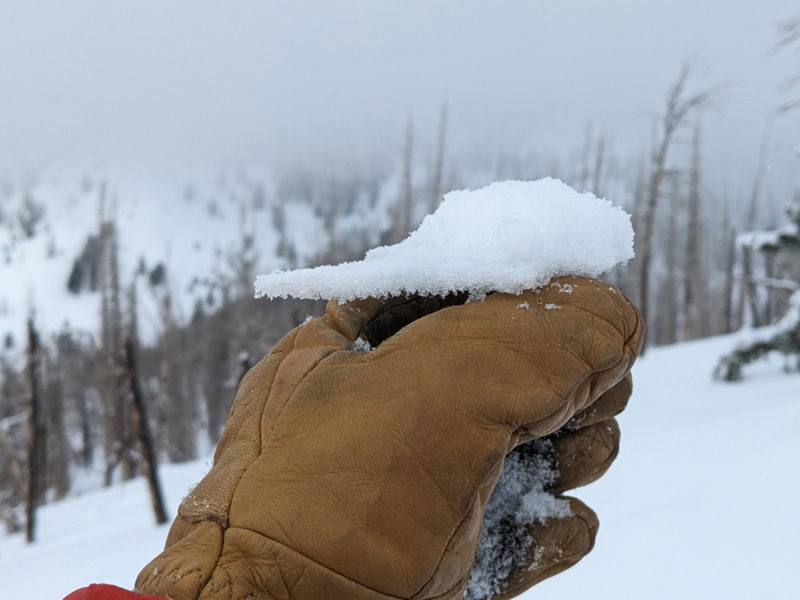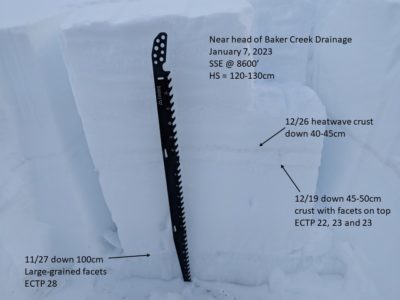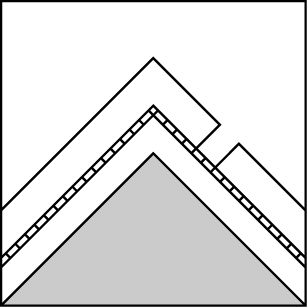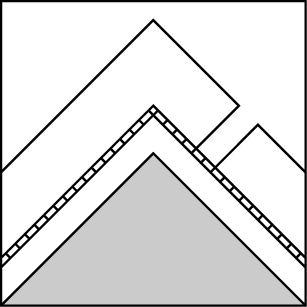Basic Information
Observation Details
Observation Date:
January 7, 2023Submitted:
January 8, 2023Observer:
SAC - VandenBos, O'ConnorZone or Region:
Galena Summit and Eastern MtnsLocation:
Baker Creek to Bear Peak (6,700-9,500, all aspects)Signs of Unstable Snow
Recent Avalanches?
None ObservedCracking?
None ExperiencedCollapsing?
IsolatedSnow Stability
Stability Rating:
GoodConfidence in Rating:
ModerateStability Trend:
Bottom Line
Persistent weak layers in the upper snowpack continue to drive my decision-making in the backcountry. These layers produced unstable snowpack test scores in multiple pits today.
Media/Attachments

Advanced Information
Weather Summary
Cloud Cover:
Mostly CloudyWind:
Light , SWNew/Recent Snowfall:
12cm HN48Winds were generally calm most of the day, with light, southerly winds blowing on exposed ridgetops. Wind speed picked up a bit in the mid-afternoon. A mid-level cloud deck clung to the peaks along the Baker divide for most of the day. The base of the clouds hovered around 9,000'. Very light precip was occasionally observed, with no accumulation. Temperatures remained cold all day.
Avalanche Observations
We did not observe any new avalanche, but visibility was limited to the terrain immediately adjacent to us. We observed a few large avalanches that likely failed during the 12/11 avalanche cycle.
Snowpack Observations
Primary objectives were to look at current surfaces, to look for the rime/humidity crust that has been reported on the west side of the divide in the terrain that drains into the S Fk of the Boise, and in the mountains above Smiley Creek, and to check in on the persistent weak layers in the upper snowpack.
Surfaces: a fresh coat of 2-3mm standing SH was deposited overnight. Calm winds and cloudy skies were not having an impact on this layer when we were in the field in most places. SH had some rime deposited on it above around 9000', but was crisp and feathery below. Yesterday's (1/6) sun built crusts, but these were weaker and less widespread than the crusts I observed the previous day (1/5) in the Boulders. Suspect this area spent much of the day in clouds yesterday with an hour or two of periodic direct sun. The crusts we found were a mix of RadRx crusts and more normal MFcr, both of which looked like they could make for "good" weak layers with loading. We found a thin rime/humidity crust on both side of the Baker/Castle Creek divide, buried down 12-15cm. This became a bit more pronounced and a bit icier as we climbed, but was present to nearly the valley bottom in Baker.
Mid-pack weak layers: there is an interesting triad of surfaces buried closely together here. Down 50cm, a subtle, 1-2mm rain crust from 12/11 is capped with small facets and then some SH (12/19). Another few cms up is the MFcr from the Christmas heat-wave (12/25-26) and wet snow from (12/27). The middle of this stack (12/19) produced a mix of propagating and non-propagating results on both sunny and shady slopes.
N at 8000', HS=130-140cm: 12/19 down 45-50cm, ECTP18, 23, and ECTN19, 23. 11/27 down 110cm, no test performed. This layer is gradually gaining strength but the structure remains poor and the FC/DH at the top of the interface remain dry and mostly angular, with hardness inching into the 4F range.
SSE at 8,600', HS=120-130cm: 12/19 down 45-50cm, ECTP 22, 23, 23. 11/27 down 100cm produced ECTP 28.
Basal weak layer:
N at 8000', 11/27 down 110cm.
SSE at 8,600', 11/27 down 100 cm: ECTP 28. As observed in north-facing pit, this layer is slowly gaining strength but I'm a long ways from forgetting about it. The FC/DH are still dry and generally angular, with hardness inching into the 4F range. Just a week ago, I remotely triggered an avalanche large enough to bury a person involving this layer just a few miles from here. The slab was much denser and thinner there, but the weak layer looked similar. We will continue to deal with this weak snow for quite some time here. And, if today's snowpack isn't complex enough for you, you can always ask the question: what happens when we go into meltdown mode in the spring and this layer starts getting wet....? ;) Ooops, getting waaaay ahead of myself, one day at a time.
12/26: The Christmas heat-wave crust +/- facet combo is a weird section of snow, and varies significantly by aspect and elevation. Today, we found it to be a well-bonded portion of the upper slab. In other places I've found it accompanied by facets and producing ECTPs.

Avalanche Problems
| Problem | Location | Distribution | Sensitivity | Size | Comments |
|---|---|---|---|---|---|
 Persistent Slab
Persistent Slab
|
|
Weak Layer(s):
Dec 19, 2022 (FC)
Comments: This layer appears to be at its worst and most consistent where accompanied by crusts on solars, but continues to produce variable ECTs with some propagating and some non-propagating scores on shaded slopes in some pits. Rose shaded where directly observed today. |
|||
 Deep Persistent Slab
Deep Persistent Slab
|
|
Weak Layer(s):
Nov 27, 2022 (FC)
Comments: Rose shaded where this problem is known to exist. It originally presented itself as a worse on shaded slopes issue, but multiple large to very large human triggered avalanches on this layer on S slopes in the past week shouldn't be ignored (nor should todays ECTP 28).. |
We did not encounter a wind slab problem today. Some aging drifts from the past week produced isolated collapses, but these are almost certainly sitting on persistent grains.
Terrain Use
We cautiously entered select avalanche terrain in the low 30s, after much discussion about consequences, likely trigger points, etc. There are many, many places you couldn't pay me to go right now.
